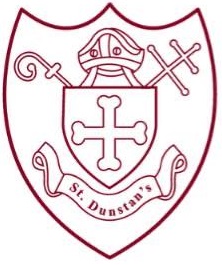Computing
Intent
All pupils at St. Dunstan’s have the right to have rich, deep learning experiences that balance all the aspects of computing. With technology playing such a significant role in society today, we believe ‘Computational thinking’ is a skill pupils must be taught to be able to participate effectively and safely in this digital world.
A high-quality computing education equips pupils to use creativity to understand and change the world. Computing has deep links with mathematics, science, design and technology and provides insights into natural and artificial systems.
At St. Dunstan’s, the core of computing is Computer Science, in which pupils are introduced to a wide range of technology, including laptops, iPads and interactive screens, allowing them to practice and continually improve the skills they learn. This ensures they become digitally literate to express themselves and develop their ideas through information and computer technology– at a level suitable for the future workplace and as active participants in a digital world.
Implementation
Our curriculum is designed with three strands which run throughout:
- Computer Science
- Information technology
- Digital literacy
Based on the National Curriculum, our progression document shows the skills being taught in each year group and how these skills develop yearly to ensure that attainment targets are met at the end of each key stage.
Based on the Kapow Scheme for Computing, our long-term plan maps the curriculum into five key areas, creating a cyclical route through which pupils can develop their computing knowledge and skills by revisiting and building on previous learning:
- Computer systems and networks
- Programming
- Creating media
- Data handling
- Online Safety
Lessons incorporate various teaching strategies, from independent tasks, paired and group work, and unplugged and digital activities.
Computing lessons are timetables weekly, giving pupils many opportunities to revisit and embed learning.
We have a bank of laptops, I-pad, Bee-bots and interactive screens to deliver this curriculum.
Impact
Our Computing curriculum is high quality, well-thought-out and planned to demonstrate progression. If children keep up with the curriculum, they are deemed to be making good or better progress. In addition, we measure the impact of our curriculum through the following methods:
- A reflection on standards achieved against the planned outcomes
- Children can understand and apply the fundamental principles and concepts of computer science, including abstraction, logic, algorithms and data representation;
- Children can analyse problems in computational terms and have repeated practical experience in writing computer programs to solve such problems;
- Children can evaluate and apply information technology, including new or unfamiliar technologies, analytically to solve problems;
- Children are responsible, competent, confident and creative users of information and communication technology.
- Tracking of gains in end-of-unit quizzes and knowledge harvests;
- Pupil discussions about their learning
Internet Safety
St. Dunstan’s Primary takes Internet safety extremely seriously. We have an Online Safety Policy that guides teachers and children on how to use the Internet safely. Every year group participates in lessons on online safety, and children understand how to stay safe when using technology.
